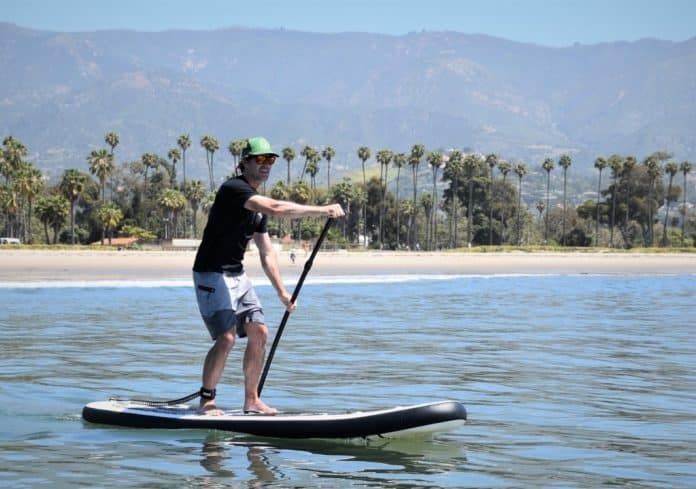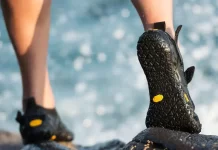Regarding stand-up paddleboarding (SUP), the question of how often to rotate your grip can be a common concern for beginners and experienced paddlers alike. Finding the right balance between a firm grip and allowing your wrists to move freely can significantly impact your performance and prevent fatigue.
In this article, we explore the importance of grip rotation in SUP paddling and provide some valuable tips to help you find the perfect rhythm for your strokes. So grab your paddle, and let’s dive into the world of grip rotation on the water!
Benefits of Grip Rotation
Improved paddling efficiency
Grip rotation plays a crucial role in improving paddling efficiency. By periodically changing our grip on the paddle, we can engage different muscle groups and distribute the workload more evenly. This helps to prevent muscle fatigue and allows us to maintain a consistent paddling rhythm.
Reduced strain on muscles and joints
We are regularly rotating our grip while paddling helps to reduce strain on our muscles and joints. When we hold the paddle in the same position for an extended period, specific muscle groups can become overworked, leading to discomfort or even injury. By rotating our grip, we can alleviate this strain and maintain a more balanced and comfortable paddling experience.
Better balance and stability
Grip rotation contributes to better balance and stability on the paddleboard. As we rotate our grip, we naturally engage our core muscles and promote a more stable posture. This increased stability allows us to navigate rough or choppy waters better, ensuring a safer and more enjoyable paddling experience.
Enhanced maneuverability
By regularly rotating our grip, we enhance our maneuverability on the water. Different grip positions provide varying degrees of control and power, allowing us to make quick turns or navigate obstacles effortlessly. Grip rotation enables us to adapt to changing conditions and achieve optimal performance while paddleboarding.
Factors to Consider
Paddling conditions
The frequency of grip rotation during SUP paddling depends on several factors, including the conditions in which we are paddling. In windy or challenging conditions, we should rotate our grip more frequently to maintain stability and control. On the other hand, in calm or downstream situations, we may not need to rotate as often.
Board and paddle design
The design of our paddleboard and paddle also affects how often we should rotate our grip. Longer paddles or those with larger blades may require less frequent rotation as they provide more power with each stroke. Conversely, shorter paddles or those with smaller blades may benefit from more frequent grip rotation to maintain efficiency.
Personal fitness and strength
An individual’s personal fitness and strength level should also be taken into account when determining grip rotation frequency. Stronger individuals may find they can sustain more extended periods of paddling without needing to rotate their grip as often. However, it is essential to avoid overexertion and listen to our bodies, adjusting the frequency of rotation accordingly.
Level of experience
Novice paddlers may find it more challenging to maintain proper technique and form, making more frequent grip rotation necessary. As we gain experience and improve our paddling skills, we may be able to reduce the frequency of grip rotation while still maintaining efficiency and comfort. It is essential to start with a comfortable frequency and gradually adjust as our skills progress.
Frequency for Recreational Paddlers
Every 10-15 strokes
For recreational paddlers, a general guideline is to rotate the grip approximately every 10-15 strokes. This frequency helps to prevent muscle fatigue and maintain a consistent paddling rhythm. It also allows for the engagement of different muscle groups, contributing to better overall efficiency on the water.
Varies depending on fatigue level
The frequency of grip rotation may vary depending on our level of fatigue. If we become tired during a paddling session, it is advisable to increase the frequency of grip rotation to avoid straining muscles and joints. By listening to our bodies and adjusting accordingly, we can ensure a safer and more enjoyable paddling experience.
More rotation may be needed in windy conditions.
In windy conditions, it is generally necessary to increase the frequency of grip rotation. The strong gusts of wind can create instability, and more frequent grip rotation helps to counterbalance these external forces. By adapting to the conditions and adjusting our grip rotation accordingly, we can maintain control and stability on the water.
Frequency for Competitive Paddlers
More frequent grip rotation for a faster cadence
Competitive paddlers often require a faster cadence to achieve higher speeds. To maintain this increased rhythm, a more frequent grip rotation is necessary. Every 5-7 strokes, rotating the grip helps to optimize the acceleration and maintain the desired pace, ultimately leading to better performance in races and competitions.
Every 5-7 strokes
To keep up with the intensity of competitive paddling, rotating the grip approximately every 5-7 strokes is a good guideline. This rapid rotation allows for quick adjustments and a seamless transition between strokes, enabling paddlers to maintain momentum and speed.
Allows for quicker acceleration and top speeds
By incorporating more frequent grip rotation, competitive paddlers can achieve quicker acceleration and reach top speeds more efficiently. The ability to adapt and adjust the grip position seamlessly allows for optimal power transfer with each stroke, ultimately resulting in improved performance on the water.
Correct Grip Technique
Hold the paddle with a relaxed grip.
Maintaining a relaxed grip on the paddle is essential for proper technique. Squeezing the paddle too tightly can lead to unnecessary tension in the arms and shoulders, causing fatigue and discomfort. By holding the paddle with a relaxed grip, we allow for natural movement and fluidity in our strokes.
Maintain straight wrists throughout the stroke.
Throughout the paddle stroke, it is essential to keep our wrists straight. This helps to prevent strain and reduces the risk of injury. Keeping our wrists aligned with the paddle shaft allows for efficient power transfer and ensures energy is directed toward propelling us forward.
Avoid excessive tension in the arms and shoulders.
Excessive tension in the arms and shoulders can hinder our paddling performance and lead to fatigue. It is essential to be mindful of unnecessary tension and consciously work to relax these muscles. By maintaining a loose and fluid movement, we can maximize efficiency and reduce the risk of muscle soreness.
Signs of Fatigue
Decreased power in strokes
When we start to feel fatigued, one of the first signs is a noticeable decrease in power during our strokes. We may find it more challenging to maintain the same level of force and control, resulting in a slower paddling pace. This indicates that it may be time to take a break and rotate our grip more frequently.
Difficulty maintaining proper form
Fatigue can also affect our ability to maintain proper form throughout the paddle stroke. As our muscles tire, we may slump or lose the correct posture, putting strain on our back and shoulders. Maintaining the correct form signals that we need to rest and recharge.
Increased muscle soreness
Another sign of fatigue is increased muscle soreness after paddling. If we notice that our muscles are feeling excessively sore, it may be an indication that we are not rotating our grip frequently enough or not taking enough breaks. We must listen to our bodies and adjust our paddleboarding routine to prevent overexertion.
Importance of Regular Breaks
Rest and stretch every 20-30 minutes.
Taking regular breaks during our paddleboarding session is crucial for preventing fatigue and maintaining optimal performance. Every 20-30 minutes, it is recommended to rest and stretch our muscles. This allows us to relax and recharge, reducing the risk of muscle strain and injury.
Rotate shoulders and wrists during breaks.
During breaks, it is beneficial to rotate our shoulders and wrists to relieve tension and promote flexibility. These movements help to improve blood circulation and prevent stiffness in these areas. By incorporating these rotations into our breaks, we can enhance overall comfort and prevent muscle fatigue.
Rehydrate and refuel to prevent fatigue.
Hydration and nutrition are critical factors preventing fatigue and maintaining energy levels during paddling sessions. It is essential to rehydrate regularly and refuel with snacks or energy-rich foods. Staying adequately nourished and hydrated ensures that our muscles and mind function optimally, allowing us to paddle efficiently for extended periods.
Guidelines for Beginners
Start with a comfortable grip rotation frequency.
For beginners, it is essential to start with a grip rotation frequency that feels comfortable and manageable. Starting with a lower frequency of grip rotation allows new paddlers to focus on developing proper technique and becoming familiar with the paddle stroke. As confidence and strength improve, the frequency can be gradually increased.
Gradually increase rotation as strength improves.
As our strength and endurance improve, we can gradually increase the frequency of our grip rotation. This progression allows our muscles to adapt and become accustomed to the increased demands of more frequent grip rotation. By gradually pushing our limits, we can improve our paddling efficiency and performance.
Seek guidance from instructors for proper technique.
Seeking guidance from experienced instructors is highly recommended for beginners. Instructors can provide valuable insights and feedback on proper technique, including grip rotation. Learning the correct grip rotation technique from the start will help beginners establish good habits and prevent the development of poor form or unnecessary strain on muscles and joints.
Advanced Techniques
Experiment with different grip rotation frequencies
Once we have mastered the basics of grip rotation, we can experiment with different frequencies to find the rhythm that best suits our paddling style. Some paddlers may find that a slightly higher or lower frequency of grip rotation works better for them. Through trial and error, we can fine-tune our technique and optimize our paddling efficiency.
Develop a rhythm that suits your paddling style.
Every paddler has a unique style and rhythm that feels most comfortable and effective. As we gain experience and become more in tune with our bodies and the water, we can develop a rhythm that suits our paddling style. This personalized rhythm ensures smooth and efficient strokes, allowing us to maximize our performance on the water.
Combine grip rotation with body rotation for optimal power
To achieve optimal power and efficiency, it is essential to combine grip rotation with body rotation. By engaging our core muscles and twisting our torso during each stroke, we generate power from our entire body. This integration of grip rotation and body rotation maximizes our paddle stroke efficiency and allows us to navigate the water with greater ease.
Adapting to Changing Conditions
Increase grip rotation in headwinds or crosswinds.
When faced with headwinds or crosswinds, it is necessary to increase the frequency of grip rotation. These challenging conditions create instability and may require more frequent adjustments to maintain balance and control. By adapting our grip rotation to the wind direction, we can effectively counteract its effects.
Reduce rotation in calm or downstream situations.
In calm or downstream situations, the need for frequent grip rotation is often reduced. With less resistance from the water, it may be more efficient to maintain a consistent grip position for more extended periods. However, it is still important to periodically rotate the grip to prevent muscle fatigue and maintain overall comfort.
Adapt to waves or choppy water for stability.
When paddling in waves or choppy water, stability becomes a primary concern. Increasing grip rotation during these conditions can help improve balance and stability on the paddleboard. By adapting our grip position to the changing water surface, we can effectively navigate through waves and maintain control.
In conclusion, grip rotation is a fundamental technique that offers numerous benefits for paddlers of all levels. From improving efficiency and reducing strain on muscles and joints to enhancing maneuverability and balance, grip rotation is an essential skill.
By considering factors such as paddling conditions, board and paddle design, personal fitness, and experience level, we can determine the optimal frequency of grip rotation for our individual needs. Regular breaks, correct grip technique, and listening to our bodies are crucial to preventing fatigue and avoiding injury.
Whether recreational or competitive paddlers, beginners, or advanced, grip rotation is a powerful tool that allows us to enjoy and excel in SUP paddling.





































